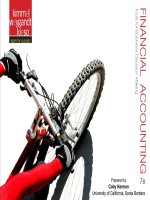Practical financial managment 7e LASHER chapter 5
Bạn đang xem bản rút gọn của tài liệu. Xem và tải ngay bản đầy đủ của tài liệu tại đây (548.79 KB, 79 trang )
Chapter 5 – The Financial System, Corporate Governance, and Interest
The Financial System
The economy is divided into sectors
–
–
Consumption
Production (includes government)
Services, products, and money flow between the sectors every day
–
–
–
–
Producers pay wages
Workers spend incomes
Producers spend revenues
Creates a cyclical flow of money
2
Figure 5-1 Cash Flows Between Sectors
3
Diagram Omits Two Things
Consumption sector
– Most people do not consume all of their income—they deposit savings and
earn a return
Production sector
– Companies need to raise money to finance large, infrequent projects
Economy has a need for and a source of $
4
Savings and Investment
Financial markets channel consumer savings to companies through the
sale of financial assets
– Companies issue securities
– Consumers purchase securities
5
Figure 5- 2 Flows Between Sectors
6
The Term “Invest”
Individuals invest by putting savings into financial assets: stocks, bonds,
etc.
This makes funds available for business investment
Hence: SAVINGS = INVESTMENT
(Consumer) Savings = (Business) Investment
7
Raising and Spending Money
in Business
Firms spend two kinds of money
– Day-to-day funds
– Large sums needed for major projects
8
Raising and Spending Money
in Business
Firms to raise money by:
Borrowing money: Debt Financing
Selling stock: Equity Financing
Term
The length of time between now and the end (or termination) of something
– Long-term projects
last over 5-10 years
financed with debt (bonds) and equity (earnings/stocks)
–
Short-term projects
last less than 1 year
financed with short-term funds (bank loans)
–
Process is known as maturity matching
10
Financial Markets
Capital Markets
– Trade in stocks and long-term debt
Money Markets
– Trade in short term debt securities
Federal government issues a great deal of short-term debt
11
Financial Markets:
Primary and Secondary Markets
Primary Market: Initial sale of a security
– Proceeds go to the issuer
Secondary Market: Subsequent sales of the security
– Between investors
– Company not involved
12
Primary and Secondary Markets
Corporations care about a stock’s price in the secondary
market
– Influences how much money can be raised in future stock issues
– Senior management’s compensation is usually tied to stock price
13
Direct and Indirect Transfers, Financial Intermediaries
Primary market transactions can occur
Directly
–
Issuer sells directly to buyers
or through an investment
bank
–
Indirectly
Financial intermediary sells shares in
itself and invests the funds collectively
on behalf of investors
Mutual fund is an example
Portfolio is collectively owned
–
–
–
Investment bank lines up
investors and functions as a
broker
14
Figure 5-3 Transfer of Funds
15
Direct and Indirect Transfers, Financial Intermediaries
Institutional investors play a major role in today’s financial markets
– Own ¼ of all stocks, make over ¾ of all trades
– Examples include:
Mutual funds
Pension funds
Insurance companies
Banks
16
The Stock Market and
Stock Exchanges
Stock market—a network of exchanges and brokers
Exchange—a marketplace such as NYSE, AMEX, NASDAQ, & regional
exchanges
•
Brokerage houses employ licensed brokers to make securities transactions
for investors
17
Trading—The Role of Brokers
What brokers do…
– An investor opens an account with a broker and place trades via phone
or online
– Local broker forwards order to floor broker on the exchange trading floor
– Trade confirmation is forwarded to local broker and investor
18
Figure 5-4 Schematic Representation of a Stock Market
Transaction
19
Exchanges
New York Stock Exchange (NYSE)
NYSE MKT (Previously AMEX)
(NASDAQ)
Regional stock exchanges (Philadelphia, Chicago, San Francisco, etc.)
Exchanges are linked electronically
20
Stock Market and Exchanges
Stock Market refers to the entire interconnected set of places, organizations and
processes involved in trading stocks
Regulation
–
–
–
Securities Act of 1933
Required companies to disclose certain information
Securities Exchange Act of 1934
Set up Securities and Exchange Commission (SEC)
Securities law is primarily aimed at disclosure
21
Private, Public, and Listed Companies, and the OTCBB Market
Privately Held Companies
Publicly Traded Companies
Can’t sell securities to the general
Received approval from SEC to offer
public
securities to the general public
–
Sale of securities is strictly
regulated
–
Process of obtaining approval and
registration is known as ‘going public’
Private, Public, and Listed Companies, and the NASDAQ Market
– Public Companies
Use an investment banking firm to “go public”
Prospectus—provides detailed information about company
SEC reviews prospectus
–
Red Herring - an unapproved, or preliminary, prospectus
23
Private, Public, and Listed Companies, and the OTC Market
The IPO
–
–
–
Initial public offering (IPO) is the initial sale
Investment banks usually line up institutional buyers prior to the actual securities sale
IPO occurs in primary market, then trading begins in the secondary market
– IPOs are discussed in detail in Chapter 8
24
The OTCBB Market
After a company goes public, its shares can trade in the over-the-counter
(OTC) market
Firms not listed on an exchange trade through the OTCBB overseen by the
NASD
Eventually a firm may list on an exchange
25









